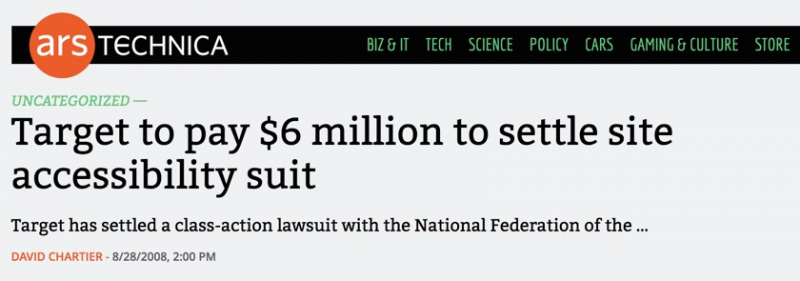As a site owner and brand, making sure your online business and website is accessible and getting the most out of each user visit is always of the utmost importance. This is especially true in today’s age with more people accessing your site through their tablets and mobile devices.

However, when it comes to the ‘website accessibility’ that we are referring to, it’s not just about making your site responsive and making sure it loads across different platforms. Instead, we are talking about the best practice of making your site accessible to everyone–especially with any disabilities or limitations that may affect how they can use your site.
Today we are going to highlight some of the most important things site owners and brands of all sizes must know and understand, in order to keep the future of their online business and sites safe.
And if you are completely new to the concept of web accessibility and how to make your site compliant, using an AI-driven automated platform is one of the quickest and easiest ways to get started. The other solution is manual remediation through coding.
You start off with a free tool like WAVE or aCe that can check the current accessibility of your current site, while recommending what changes should be made to further improve your site usage. And move on to solving the problem one by one, or site-wide with an AI solution (more in this later on).
For this reason and more, 2020 is the year site owners and online businesses must learn about and adapt to the latest changes and regulations in reference to website accessibility for all audiences.
The Law States Your Site Must Be ADA/WCAG Compliant
When it comes to web accessibility and the regulations around it, the two that are getting the most attention are the ADA and WCAG guidelines. Both of them are very important and focus on the importance of making sure every user has full access to all areas and services of your site, no matter what disabilities or limitations they might have.
For example, if users are coming to your site and they have visibility issues and can’t read the font size or they are affected by the colors and flashing banner ads on your site, this could make your site vulnerable to potential lawsuits or demand letters from attorneys that specialize in this space.
And if this sounds crazy, just take a moment to search Google for any of the recent stories related to site usability compliance and big brands like Target that have had to pay big money in fines, legal fees and making their sites fully compliant.

In short, unless you want to be made an example of, it’s best to try and make sure your site is compliant sooner than later. And not only could having a non-accessible site lead to you losing new site visitors and customers, it could also lead to unexpected lawsuits and legal fees.
Following Web Accessibility Guidelines is Just Good Business
Outside of the fact that it’s now a law and the necessary guidelines are in place for your site and business to follow, it’s really just a good business practice that everyone should abide by.
These types of regulations and guidelines are easy to follow and enforce in the offline world, as online businesses don’t physically see the limitations and needs visitors to their site might have.
The complete opposite is the case if you had a local business where people were actually coming in and out of your retail location. Some perfect examples of this would be having handicap accessible parking, ramps for users walking difficulty or in wheelchairs, and also allowing for seeing eye dogs or any other issues that might arise.
To better understand the needs for your online business to be web accessible and catering to the needs of all audiences, just think for a moment if your same business was local and had people coming in and out all day… What modifications and improvements would you make?
The key takeaway here is, if you aren’t catering to the needs of ALL of your audiences and customers, then it just looks bad for your brand and it’s not a good business practice.
Getting Compliant is Cheaper and Easier than You Might Think
From the site design and programming side, the thought of making your site compliant to all audiences may seem like mission impossible. And most importantly, outside of it being an expensive and huge project to take on, you simply can’t manually customize your site experience to fit everyone’s needs.
The good news is, in both of these situations, making a website accessible and fully compliant to ADA and WCAG guidelines is much easier and cost effective than you think.
At the beginning of this article, we made the distinction between two approaches:
First, using an AI powered web accessibility platform like accessiBe that can make any site fully compliant within just 48 hours by adding a quick line of Javascript code.
Second, hiring a web accessibility consultant and a web designer to re-code and design several parts of your website according to the WCAG standards.
The first approach is faster and cheaper. The way the application works is scalable and automatic – instead of needing to hard code a ton of different changes and design modifications to your site, accessiBe can make any site compliant just by adding a quick line of code.
Should the visitor have any limitations or disabilities, the user can click on the little handicap wheelchair icon and open up a whole world of site modifications and options.
You can see this Accessibility Adjustments application in action on the site screenshot below.

The process of getting such an application up and running on your site is done in a simple five-step process that even newbie site owners and mom and pop businesses can implement.
This process consists of the following.
- Install a single line of JavaScript code
- The accessibility interface instantly appears on your website
- The AI starts scanning and analyzing your website
- After up to 48 hours, your website is fully compliant and certified
- Every 24 hours, the AI scans for new and revised content to fix
With the process of making any site ADA and WCAG compliant, there really aren’t many excuses left for not implementing such a positive change.
The 2nd approach is a bit different. You make the hard-coded changes on your website for search engines and the user itself. The plus is that if you do things right your website is totally accessible.
The problem starts when you have to update your website frequently. Adding new content and information means you’d have to make it accessible as well. Installing new plugins and software fall under the same category – they change your website layout and code and so you’d have to re-hire the programmer everything you change anything on your website.
The Future of ADA/WCAG Compliance and Your Online Business
Before reading this article, there is a good chance that you’ve never heard of the rules and regulations in reference to web accessibility and how it affects visitors and customers of all types to your site.
Outside of the terrifying legal actions and costs associated with not having your site fully compliant, there are many other positives that can come as a result of it.
By making sure your site and online business is accessible by audiences, you can sleep well at night knowing that everyone is going to have a positive experience when using your brand. And even better, there is no lingering risk of legal action coming your way for not having such limitations in place.
For these reasons and more, every site owner and business need to be aware of ADA and WCAG compliance, while also making sure their site is fully accessible to all audiences.




